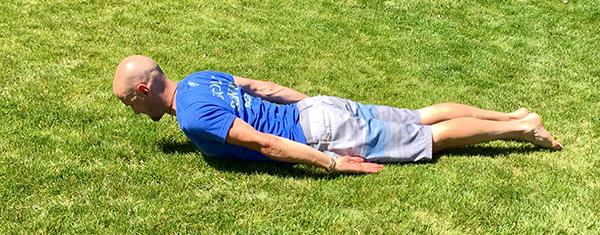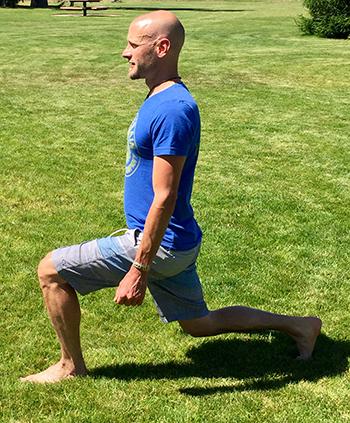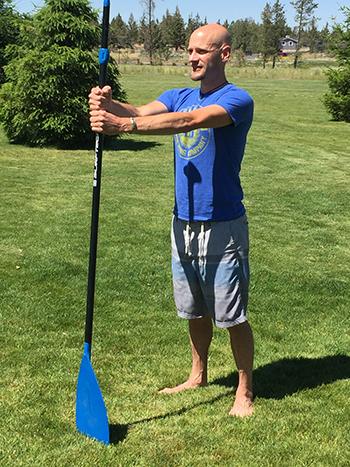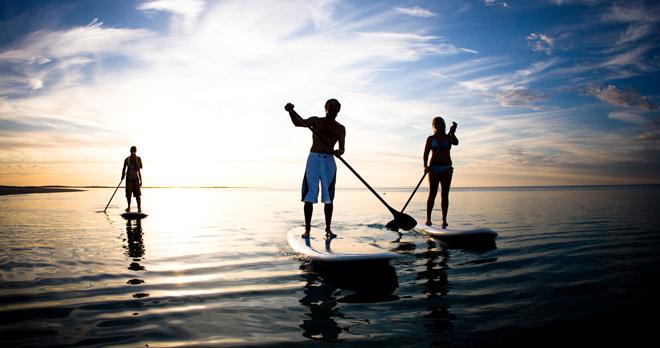Stand up Paddle boarding (SUP) is one of the great recreational activities that we have available to us here in Central Oregon. There’s nothing like getting out on the lake for an early morning sunrise paddle or a post work run down the Deschutes before the day ends. Our summer has finally arrived, time to hit the water and paddle your way to improved health!
Benefits include:
- Full body workout
- Improved balance
- Improved endurance/cardiovascular health
- Opportunity for stress release/meditative practice
Here are a few exercises to get you ready for paddle boarding or improve your ability. No need for the gym! You can do all these along the river bank or right at home.
The Plank: The abdominals work to generate the paddle stroke and maintain balance. This exercise can be done with either arms extended or on the knees dependent on your ability or strength levels. Start lying on your stomach and on your elbows. Engage/contract your lower abdominals by drawing in the belly button and performing a slight posterior tilt of the pelvis and pull your body up as you push through the arms and toes. Focus your body awareness towards the lower abdominal contraction as you maintain your body in a straight line from the shoulders through the hips and the ankles. Hold for 5-30 secs. Repeat 5-10 reps.

Prone Supermans: The lumbar extensors are actively involved in stabilizing the posterior trunk and work to maintain balance. To perform, lie flat on your stomach with our arms overhead and your head centered with the alignment of your spine. Gently draw in lower abdominals (belly button in) and then raise arms and legs off of the ground. Hold 5-10 seconds. Repeat 10 x.

If your shoulders/neck are tight an alternative is to keep the arms at your side or perform alternate arm/leg raise on your hands and knees.

Reverse lunges: Leg strength is important both for balance and stabilizing during the paddle stroke. A reverse lunge targets the extensor muscles of the lower limb. To perform start in standing and step backwards keeping trunk in midline upright position and the knees centered over the feet. Pause, then step forward with front leg to propel self back to standing (versus pushing from posterior leg). Repeat on opposite side. 1-3 sets 10-20 reps.

Balance: Balance ability is a big time key to paddleboarding. To begin, stand in your paddle board stance and look forward. If you can maintain stable position for 60 secs then close your eyes and balance for 60 secs. Key into the sensations of your body on how your feet and trunk ‘feel’. If you can perform this without losing balance then progress to eyes open/closed with feet together, tandem stance (one foot in front of other) or single leg stance. Set a goal of 3 x for 60 seconds with eyes open. Then progress to eyes closed as this targets our quick response balance strategies.
Paddle Pull down isometrics: This is a simple way to target both the arm and core muscles for your paddle stroke. Isometrics are contractions without movement. To start, stand in your paddle board stand with your paddle and arms out in front of you. Pull down and hold muscle contraction for 5-10 seconds. Repeat 5-10x. Then simulate L sided stroke with the paddle on your L side and repeat for 5-10x 5-10 secs and the same on your R side. Quick and easy!


Mr. Montgomery,
My name is Meryl Ray and I am starting a nonprofit organization this season in SW Michigan. I’ll be facilitating SUP Yoga events, each event having a tangible items donation theme. I’d like to ask your permission to use and summarize this blog article (attaching a link to your website) to motivate and prepare interested participants to get ready for SUP season, so that they can donate to a local, national, or global need all summer long.
Regards,
Meryl Ray
Mr. Montgomery,
My name is Meryl Ray and I am starting a nonprofit organization this season in SW Michigan. I’ll be facilitating SUP Yoga events, each event having a tangible items donation theme. I’d like to ask your permission to use and summarize this blog article (attaching a link to your website) to motivate and prepare interested participants to get ready for SUP season, so that they can donate to a local, national, or global need all summer long.
Regards,
Meryl Ray